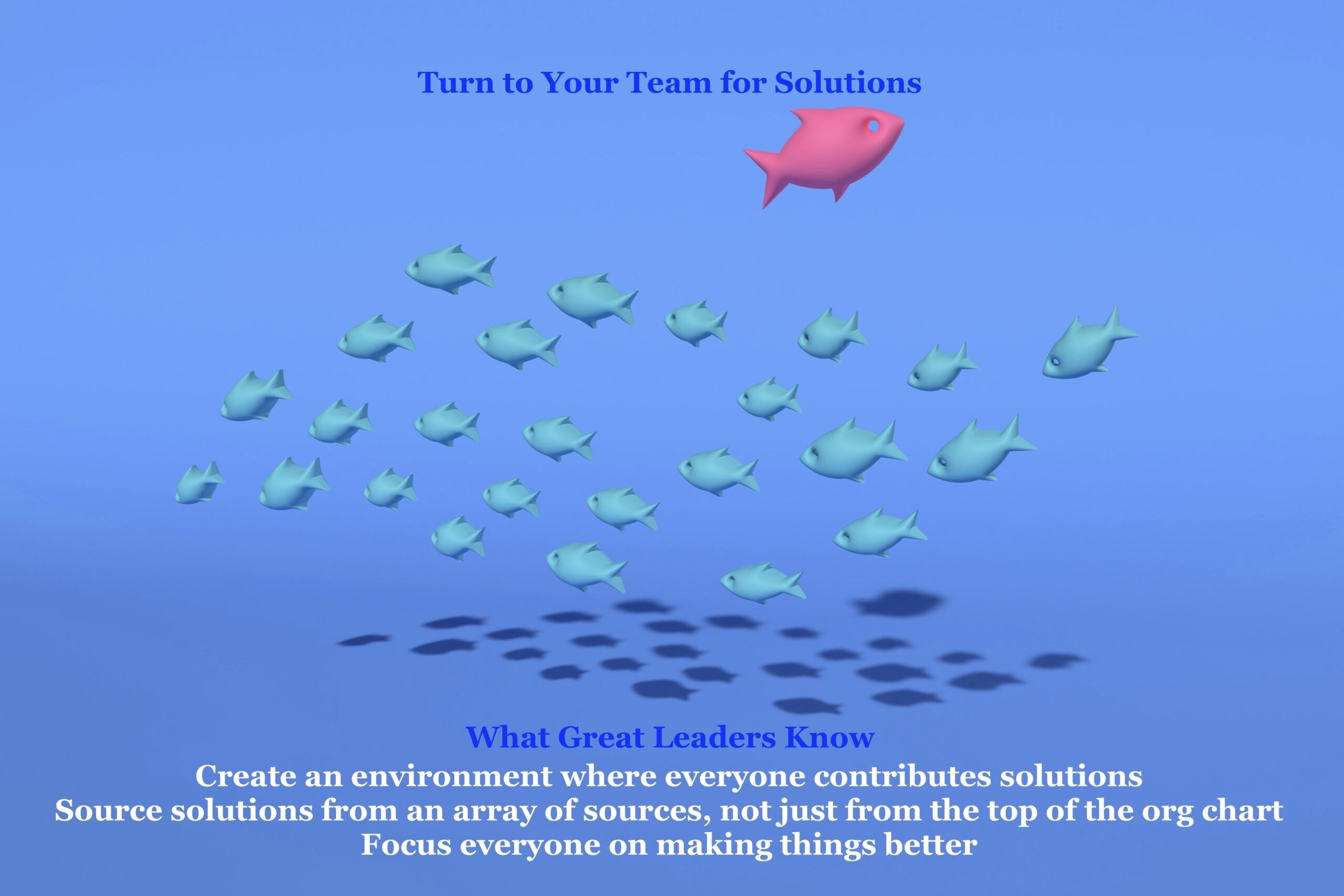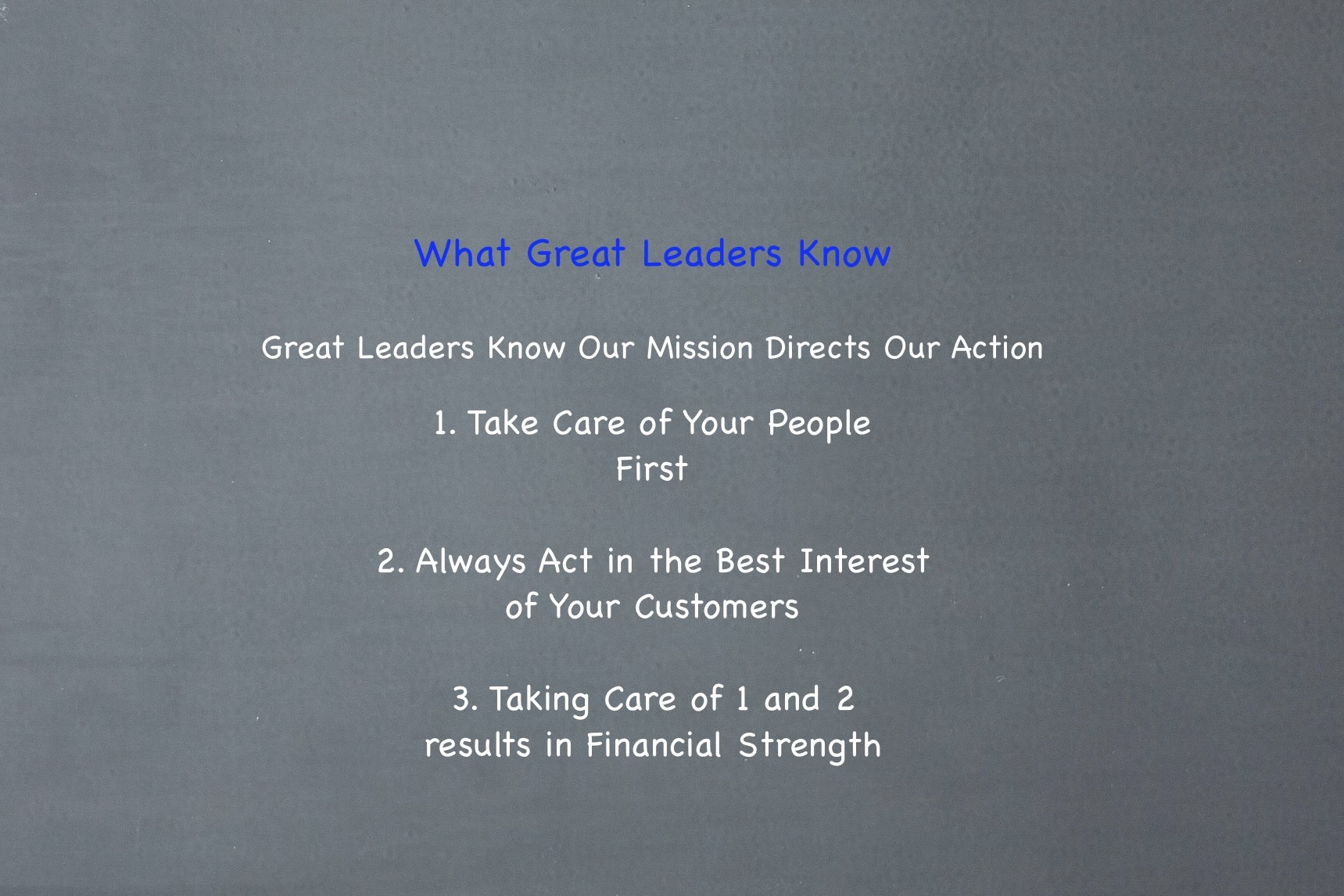Your cart is currently empty!
Tag: Business Leader

Turn to Your Team for Solutions
Many minds are better than one. Turn to Your Team for Solutions.
Have you ever worked at a job where every decision had to be made by the boss rather than turning to the team for solutions? Asking your team for solutions is a model for growth while single approval control is a misstep. Following the traditional model of business means yielding to the more senior leader as the expert in all circumstances. To be fair, nobody can be an expert at everything or should be expected to be.
Great Leaders know solutions, ideas, innovations come from an array of sources and their role is not to be the one and only solution provider, but the person who creates an environment where everyone has value and is depended upon to contribute to solving problems, innovation, growth.
The obstacle to including team members in decision making is the leader’s need to control. It may seem like the right thing to do is to defer to the boss, but this presents individuals from learning how to make decisions and grow.
When I learned to give problems back to my team, they generated amazing solutions.
Since they were hitting the roadblock day after day, they had a perspective I did not. I made it my goal to engage the team in problem solving. When they would ask me what to do, I asked them what they thought. If they provided a workable solution, I would let them introduce it and give them credit- “We’re going to follow Amy’s plan today.” As you can imagine, Amy’s stock rose among her peers and everyone on the team was motivated to provide the next solution. When other teams spent time gossiping and tuning out, mine were thinking about how can we make things better. Not everyone can offer a workable solution, but that’s not important, engaging them is important.
I remember asking my front line team how we can reduce supply costs. They knew exactly what needed to happen and we reduced supply costs by 20%. They were excited to watch our progress! I was too!
By turning to your team for solutions, employee engagement, retention rates and operational performance results will all improve, leaving the controllers in your wake.
What Great Leaders Know
Create an environment where everyone contributes solutions
Source solutions from an array of sources, not just from the top of the org chart
Focus everyone on making things better
Links
https://whatgreatleadersknow.com/
https://hbr.org/2023/03/how-to-equip-your-team-to-problem-solve-without-you

OUR MISSION DIRECTS OUR ACTION
In the first minute of my first class in business school at Westminster College, it became apparent. The professor wrote on the board, the purpose of business is to ______ _____. The rest of the class answered in unison “make money” and received a positive nod from the professor. I said “serve people”, earning me a roomful of skeptical looks.
After class, I approached the professor. “The goal of business is to provide something of value to a consumer. Above all, satisfactory service must happen or the business isn’t going to be paid (or stay paid). Service comes first. ” He stood his ground. Looking back, what I wish I had said was-
Different people have different missions, our missions direct our actions.
Great Leaders recognize their team members as their most important customers. Great service only happens when employees willingly give it because they feel satisfied. As a result, their positive actions toward customers are the manifestation. It’s clear that our mission directs our actions in our professional conduct. Ethical choices are always directed by their impact on people.
I stood alone in my MBA Business Ethics class arguing on behalf of the consumer. My classmates argued for business profits. In one memorable case, a manufacturer refused voluntary recall on cars they knew exploded during collisions because of the additional expense. Yet, my classmates also said they would not buy the exploding car for themselves. If we object to how we are treated as customers, we should not treat our customers the same way!
Mission directing Actions example
In 1982, tainted bottles of Tylenol resulted in several deaths. The poisoning happened after the bottles were on shelves and did not directly involve the manufacturer Johnson and Johnson. J&J spent $20 million to recall their product! Was this the right decision? Yes! J&J’s decision to recall Tylenol, and introduce tamper resistant caplets and containers, set a new standard for product safety, benefitting millions of customers. Tylenol increased their pain reliever market share from 35 to 37%. Today, Tylenol is an industry leader with a 37% market share. History has proven Johnson and Johnson made a wise decision in taking care of customers first.
Great Leaders Know Our Mission Directs Our Action
1. Take care of your people first
2. Always Act in the best interest of your customers
3. Taking care of number 1 and number 2 results in Financial Strength
Links
https://whatgreatleadersknow.com/
https://en.wikipedia.org/wiki/Chicago_Tylenol_murders
https://www.nytimes.com/1999/07/10/us/4.9-billion-jury-verdict-in-gm-fuel-tank-case.html

Teach, Don’t Do: A Leadership Mindset
Teach, Don’t Do Understanding what great leaders know can vastly improve your leadership skills.
The most important role a leader plays is teacher. Teach, Don’t Do is my shorthand for “Give someone a fish and you feed them for a day. Teach someone to fish and you feed them for a lifetime”, generally attributed to Chinese philosopher Lao Tzu. Successful leadership comes from knowing what great leaders know and applying it effectively.
In many cases, it is faster and easier to just fix the problem, but then, how will anyone else ever learn? Suppose, I never explained to my kids what to do when the smoke alarm starts beeping. All I ever did was say, I’ll take care of it. I’m locked in as the official smoke detector fixer. Will my kids grow up and move away and still call me when the smoke alarm battery needs replacing? Now, I am driving 4 hours in the middle of the night (smoke detector batteries always run low in the middle of the night don’t they) when I could have taught them long ago and they would have taken care of it and I would still be sleeping.
The more people who know how to do something, the more the team benefits. If only one of member of the Women’s Olympic Team has mastered the bar, the team is in trouble if that person is injured. If only one person knows how to submit payroll, when that person takes a vacation, there’s going to be a problem. Great leaders know this and ensure every team member is prepared.
Those mentors I have respected most were all excellent teachers who took stock of my abilities and challenged me move beyond them, seeing something that wasn’t yet there and understanding it could be. Investing time with me to help me grow. Wanting what was best- for me! When I grew, I applied what I had leaned, I became a stronger leader. Research shows 74% of adults consider themselves lifelong learners! Teaching them is an investment, rather than a waste of time.
My point is not that a leader should never do anything directly. Great leaders know that teaching the team is everything!
Great Leaders Know- Teach, Don’t Do
The most important role a leader plays is teacher. This is a foundational principle that great leaders know.
Make Teach, Don’t Do your mantra.
The more people know how to do something, the more the team benefits. As any great leader knows, this is vital for team success.
Links
https://whatgreatleadersknow.com
https://www.pewresearch.org/internet/2016/03/22/lifelong-learning-and-technology

Long work to do list? Start with One
What Great Leaders Know- Start With One
Facing a long work to-do list? Start with one task to make progress and stay productive. When dealing with a long work to-do list, start with one task at a time.
From 50 things to do to 1
My wife taught me a very valuable lesson to help me in a time of great frustration. I had started a new job and inherited many, many operational issues. Directing 115 front line employees alone was a ridiculous situation and working long hours didn’t help. While I worked on finding another job, I made a list of important things to do. I stopped writing when I reached 50! Frustrated mounted as day after day, I attacked my list, but never made any progress. Amy convinced me to take a different approach- start with one thing from the long work to-do list and when you can get one thing done, expand your list to two and so on.
A long work to-do list can be overwhelming; start with one task at a time to manage stress effectively. I went back to work the next day fixing my 1 issue- payroll. Having improved the payroll process, I moved on and attacked the work schedule. The other things I simply let go until I could get to them, which was hard, but necessary.
Take the Pressure Off
Sticking with the 1 thing approach lifted the weight of the world from my shoulders and I enjoyed my job again because I was doing my best and I could only do what I could do in that circumstance. What I did not expect was our team performing better. But fixing my most important issue was fixing everyone’s most important issue. Everyone benefitted.
Facing overwhelming challenges, like trying to manage 115 employees alone, all we can do is our best. So, act accordingly. Thanks Amy!
What Great Leaders Know- Start with One
Managing a long work to-do list? Start with one priority first.
When we try to do too much we accomplish nothing
Prioritize your actions
Take advice from the wise people you know
Links
https://whatgreatleadersknow.com
https://www.liquidplanner.com/blog/how-to-prioritize-work-when-everythings-1/

Mastering Leadership: Letting go without losing control
What Great Leaders Know- Southern Fried Rock and Micromanaging
I love music. One of my favorite lyrics appears in the song Hold On Loosely written by James Peterik, Jeff Carllisi, and Richard Donald Barnes for the band 38 Special. There is an unexpected leadership message in, of all places, Southern Fried Rock music. When learning to lead without micromanaging, we can take inspiration from different sources. Letting go without losing control, a lesson from an unexpected source.
“Just hold on loosely but don’t let go”
So much meaning from 8 words. For me, they describe being in a healthy relationship. A healthy relationship is crucial in leadership and avoids the pitfalls of micromanaging. By learning to lead without micromanaging, leaders build solid and trustworthy relationships. Letting go without losing control becomes essential.
Trust, commitment, communication, and boundaries
Great Leaders know healthy relationships are based on trust, commitment, communication, and boundaries. Strong relationships are formed in the forge, which is to say, time has been spent strengthening them through the trial. Great Leaders remain committed to their team members who understand they won’t let go at the first sign of trouble or even the second. Mastering the art of letting go without losing control is key.
Micromanaging is toxic
Great Leaders know micromanaging is neither a healthy nor a pleasant experience. Many managers rely on micromanaging regularly. Faced with a challenge, they return to their default setting, if you want something done right… but this will not work and drives a wedge into the relationship. Micromanaging or over-managing is neither sustainable nor beneficial for the giver or the receiver. Learning to lead without micromanaging is essential to building trust, a two-way street that strengthens the relationship. Great Leaders hold fast but allow for movement. Impeccable communications permit comfort. Thanks to Southern Fried Rock, leaders can learn to manage better. So, remember the importance of letting go without losing control.
What Great Leaders Know
Life lessons can come from unexpected places. Take Southern Fried Rock, for example, which offers insights into leadership and avoiding micromanaging. Thinking about letting go without losing control can provide deeper interpretations.
Strong relationships are formed in the forge, as discussed in both leadership and Southern Fried Rock music. This also applies to the principle of letting go without losing control.
Remain committed to your team members at all times; This shows great leadership and avoids micromanaging.
Micromanaging is destructive for the giver and receiver where trust, is crucial. Learning to lead without micromanaging encourages a healthier work environment and embodies the essence of letting go without losing control.
Links

Leadership requires Followership
People need a reason to willingly follow you consistently.
“If they ain’t followin’… you ain’t leadin’.”
Griff Thomas
Leadership depends upon followership and followership depends upon leadership. Having a title does not make you a leader. The only thing that makes you a leader is people choosing to follow you.
What Great Leaders Know
- Lead from the front and show the way
- Results of the team measure leadership effectiveness
- We win when everyone crosses the finish line
- Leadership is a team sport
Links